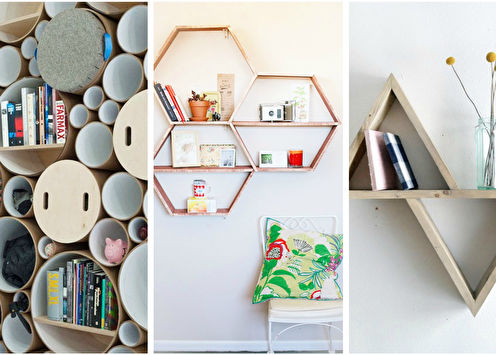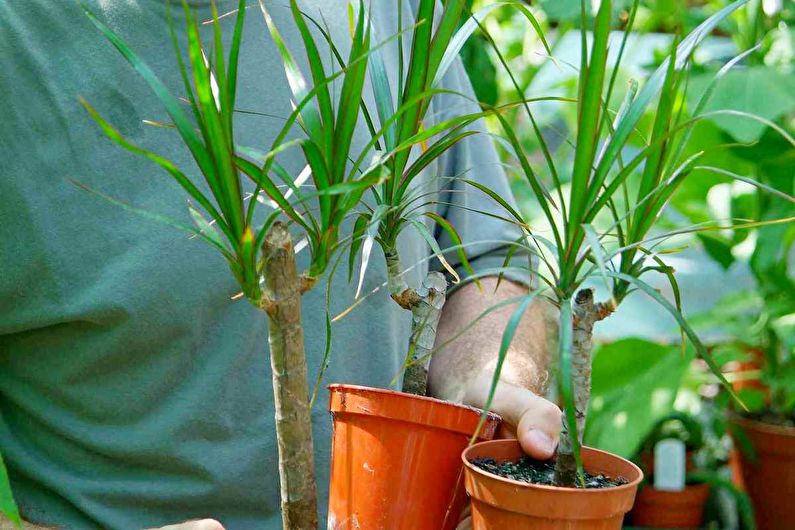
Among the wide variety of indoor plants, dracaena is a large group, which includes compact acicular palm trees, and large trees up to 1.5-2 meters high. The natural range of these evergreen herbs of the asparagus family is subtropical and tropical forests. Due to its decorative qualities and unpretentiousness in care, dracaena is ideal for landscaping apartments, offices, breeding in greenhouses and conservatories.
The main types of dracaena
Although there are more than a hundred names of wild dracaena, only about 15 are grown under indoor conditions. Depending on the species, these plants differ in stem size, size and shape of leaves, and color. The most common of them can easily be recognized in the photo, because it’s dracaena that decorate both home and public interiors everywhere.
Dracaen Sander (Dracaenasanderiana)
In appearance, it is very similar to bamboo stems, but in fact it is not. Light green with woody “rings”, the stalks of this plant at the top end with oblong pointed leaves up to 25 cm long. The total height can reach 70-100 cm. It is believed that the exotic Dracaena Sander with its beautifully interwoven cuttings brings happiness and luck to its owner .
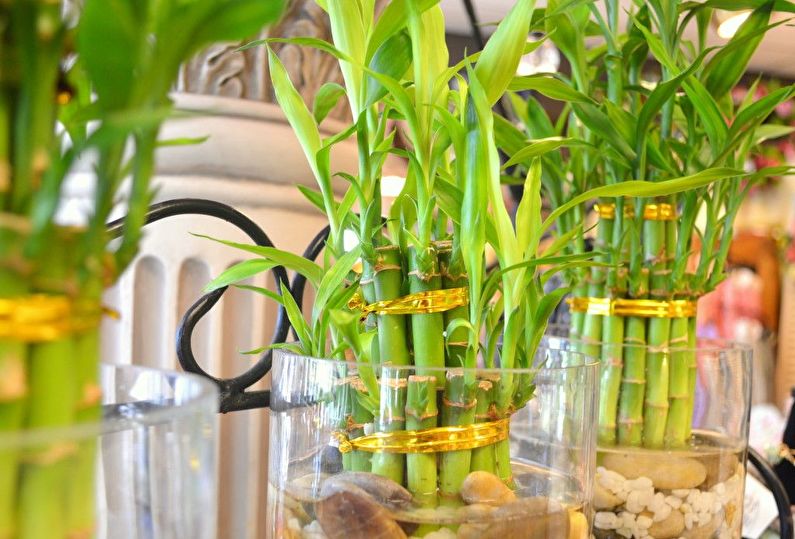
Dracaena Derema (Dracaenaderemensis)
It has long (up to 50 cm) narrow leaves of a lanceolate shape, growing upward directly from a wide stiffened trunk. The color can be either dark green or mixed, when the center of each sheet passes a white-fringed strip of a darker / lighter shade than along the edges. Pistiform red-white inflorescences appearing in the sinuses of the plant have a not too pleasant smell.
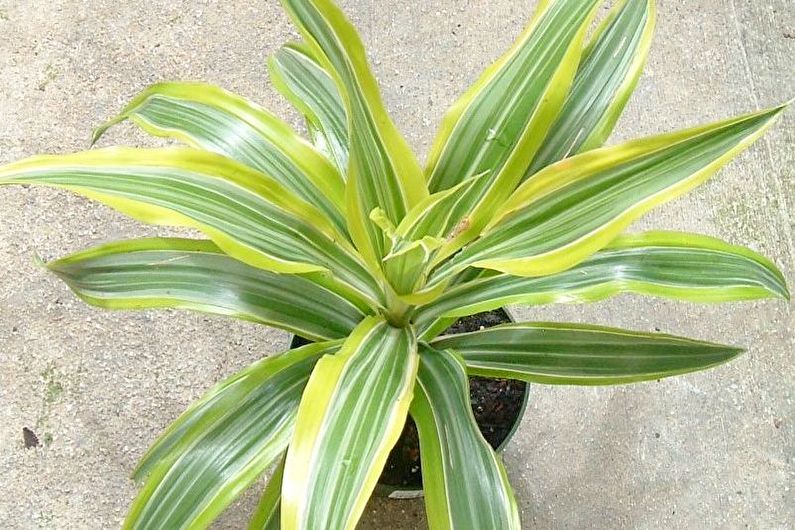
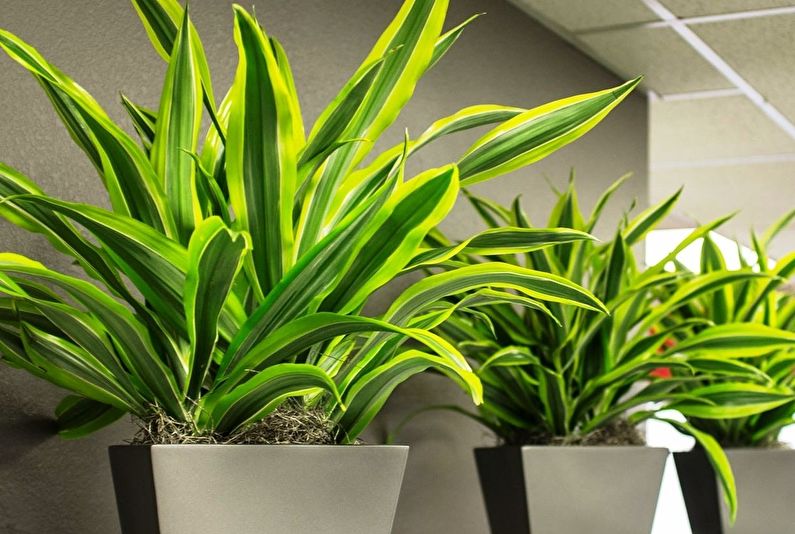
Fragrant Dracaena (Dracaenafragrans)
It is able to grow to the size of a real home tree - 2.5 m with a strong trunk and large arched leaves (width 6-8 cm, length - up to 70 cm) of a characteristic color. The name “fragrant” this dracaena acquired due to the tangible smell of freshly cut hay emanating from racemose inflorescences, which are usually cream or pinkish-greenish. This plant tolerates shade and temperature well up to + 10 ° C.
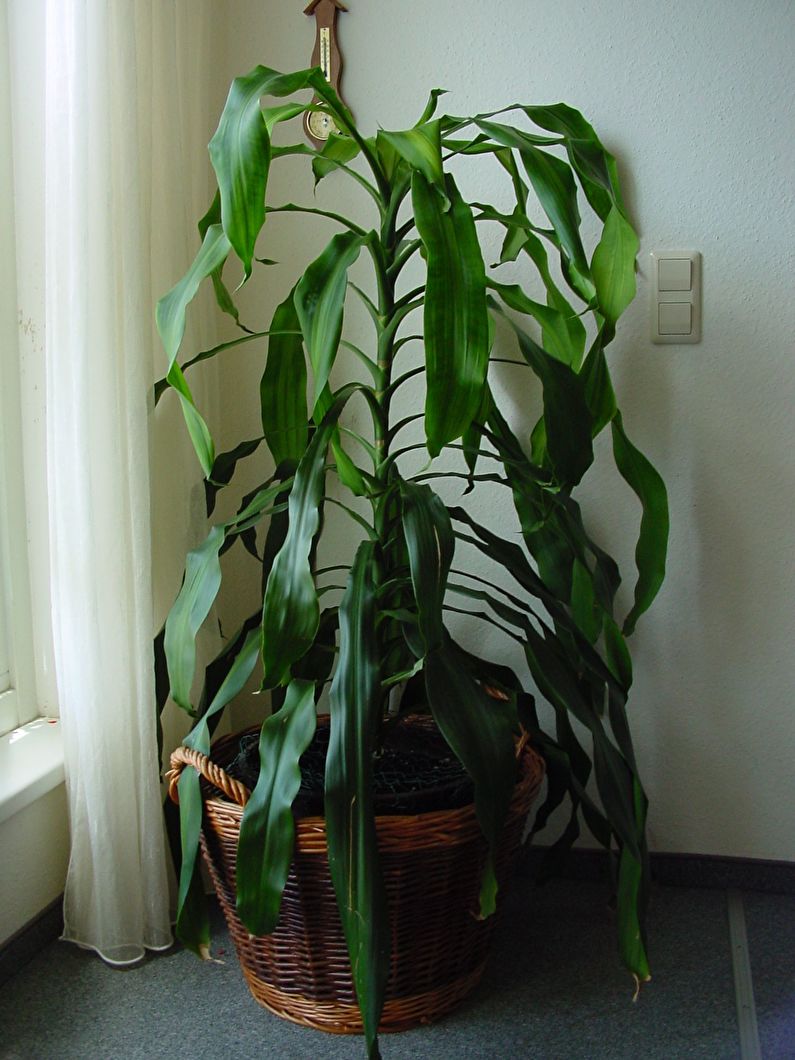
Dracaena bent (Dracaenareflexa)
It differs in that its elongated (15-20 cm) and narrow leaves with a white or cream border, which are bundles adjacent to the trunk, are slightly bent at the ends. This lush plant resembles a reduced tropical shrub, due to which it looks very decorative in any setting.
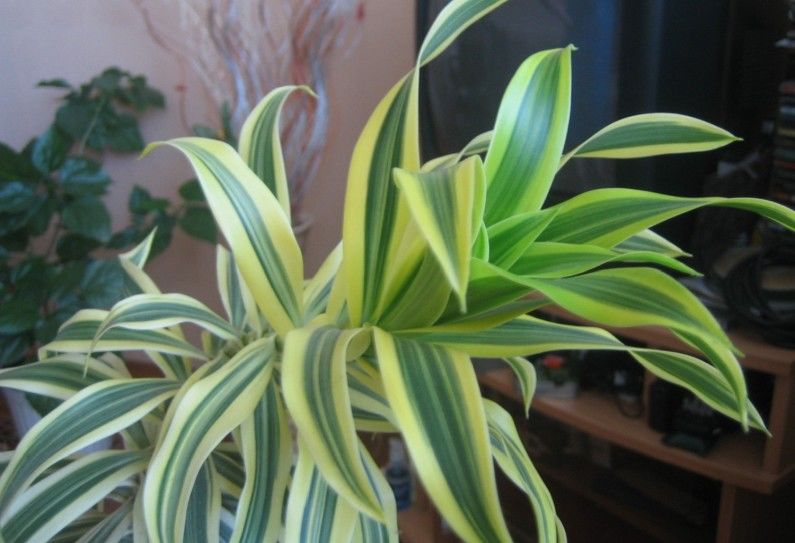
Dracaen Godsef (Dracaenagodseffiana)
It looks a little like its relatives: it does not have a trunk, and oval spotted leaves grow on thin branches directly from the ground. Chaotic yellowish-white dots on top of a green background resemble splashes of paint, but varieties are also found with a more refined pattern.
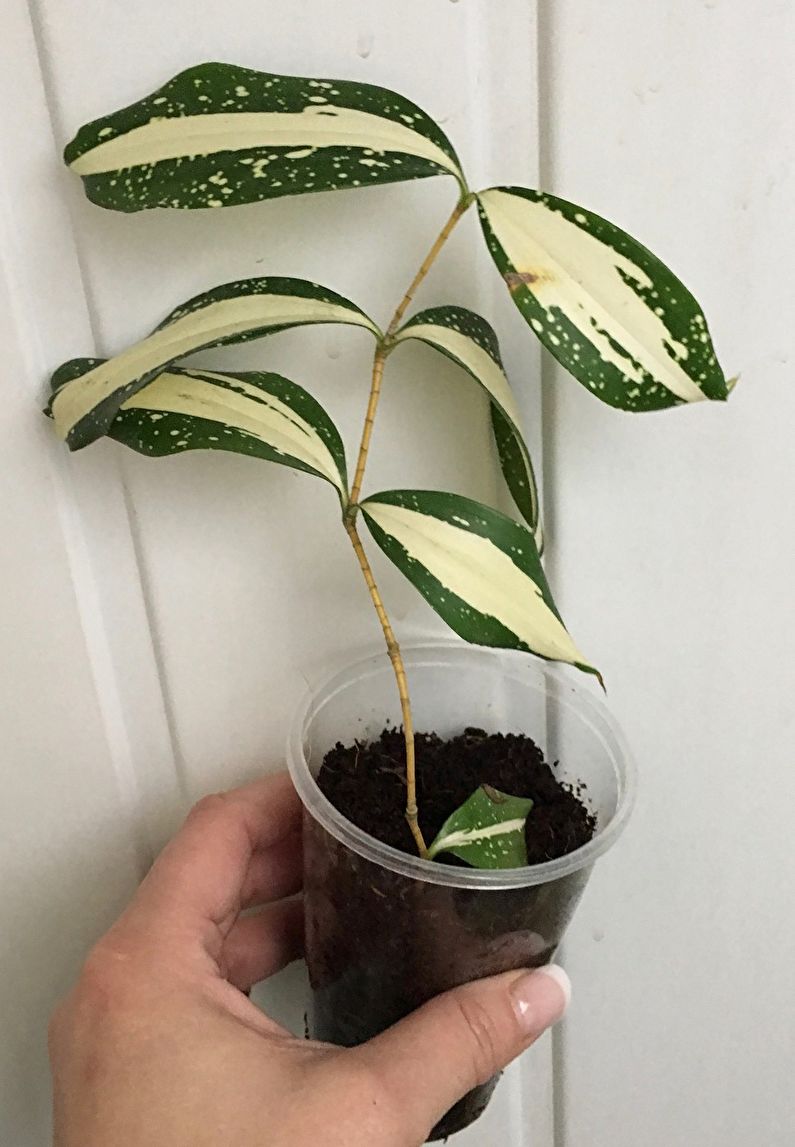
Dracaen Marginata (Dracaenamarginata)
Has the greatest resemblance to a palm tree among all other species. Its many narrow leaves are collected on a woody trunk in one or more bunches. This plant is one of the most unpretentious to lighting, loves shade and warm, humid weather.
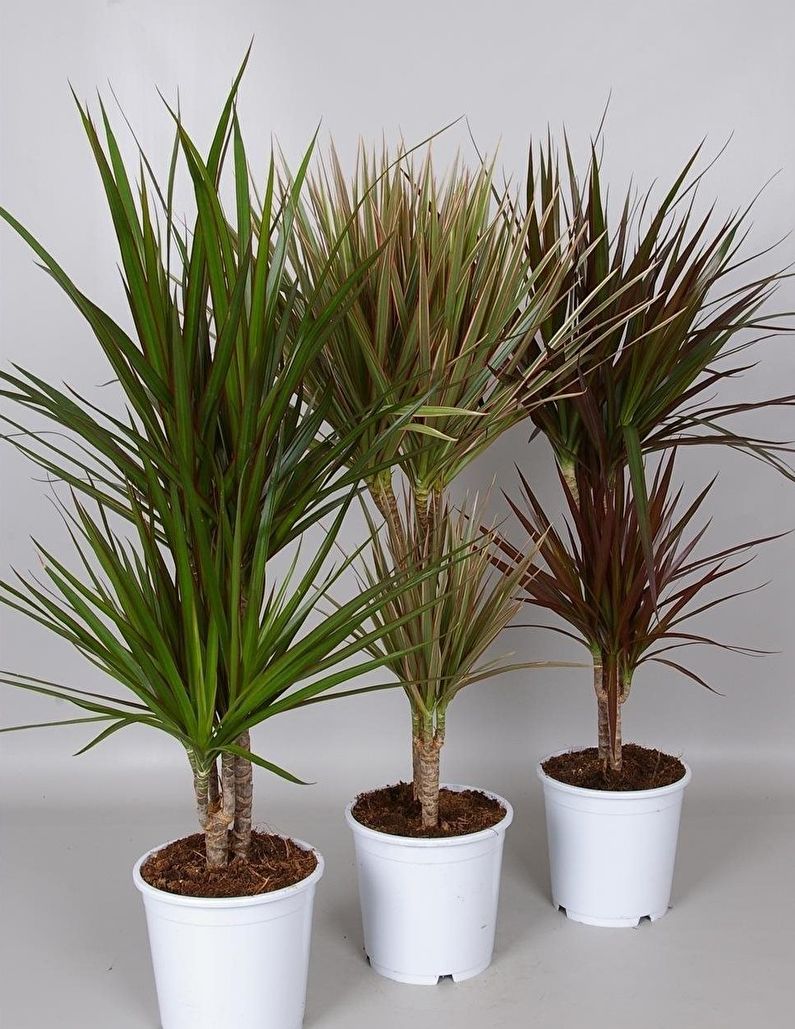
Dracaena Janet Craig (DracaenaJanetCraig)
Very beautiful tall palm tree with large, slightly wide leaves, which is ideal for growing in tubs. On a thin (up to 8 cm in diameter) green trunk several lush branches are located at once. This is an extremely useful plant from an environmental point of view - Dracaena Janet Craig and some other species perfectly filter the air, purifying it from harmful impurities and saturating with oxygen.
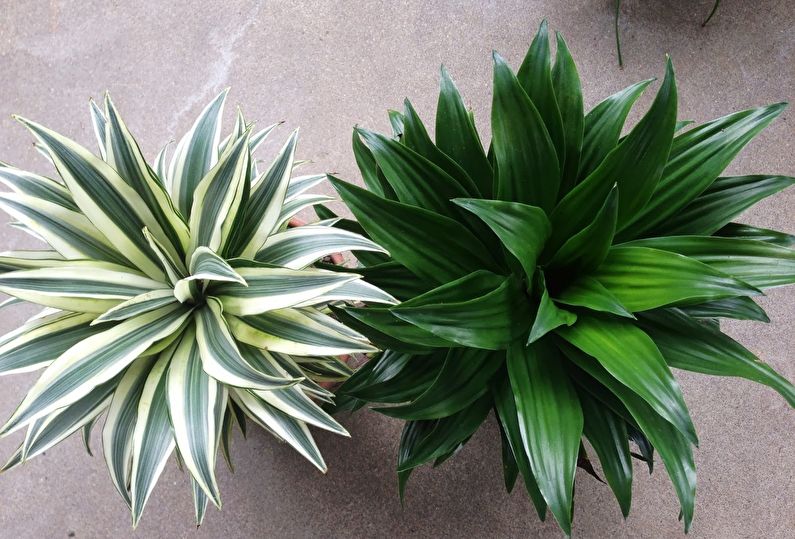
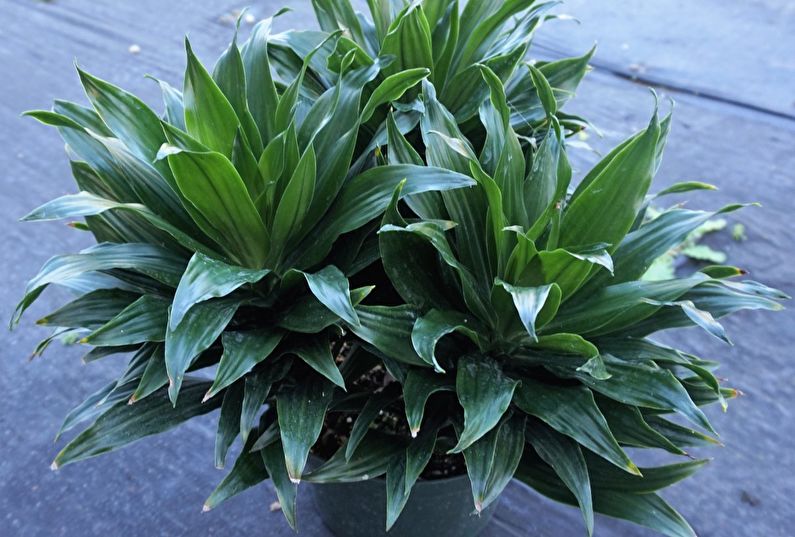
Proper Dracaena Care
Despite the fact that the ideal climate for different types of dracaena should be somewhat different, these nuances are not fundamental. In general, the plant adapts perfectly to normal home conditions, while remaining fresh and green for many years.
Temperature mode
The optimum temperature for dracaena is unobtrusive heat in the region of 20-25 ° C. In winter, it is allowed to drop to + 15 ° C, but if the air is even colder, the plant may die. From the intense heat, its leaves quickly wither, losing their attractive appearance.
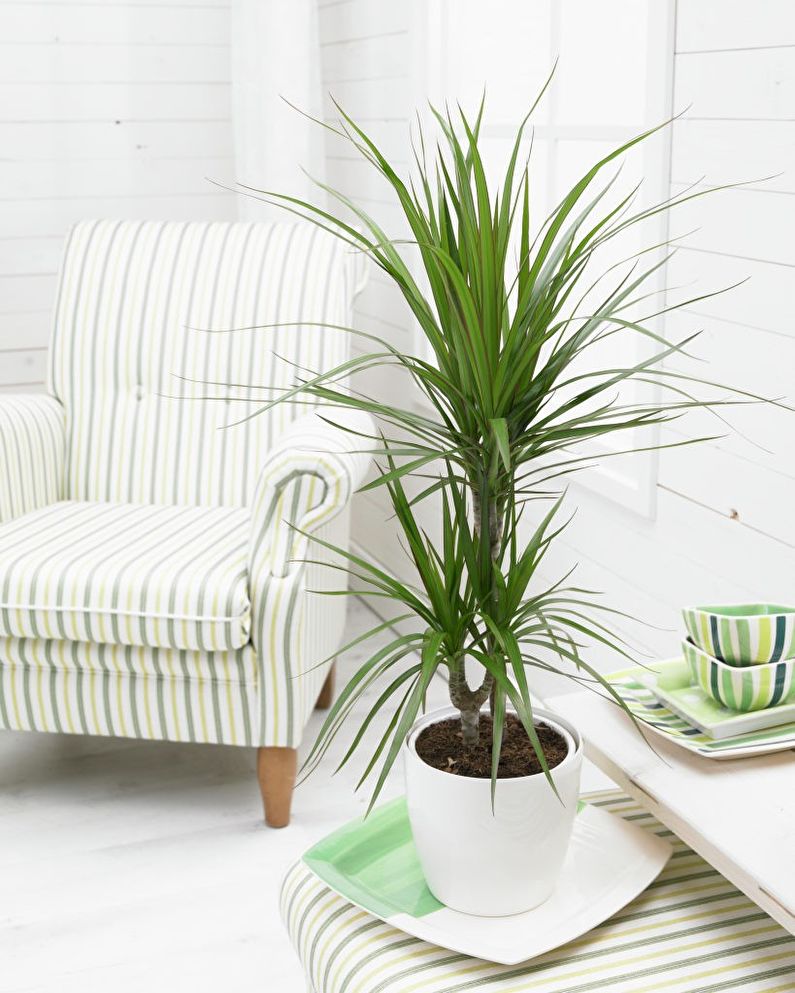
Lighting
In nature, dracaena grows in the shaded middle and lower tiers of tropical forests, so the direct rays of the midday sun are fatal to it. For this reason, do not leave pots with a decorative palm on the southern windowsills or loggias. It is better to choose a place in the apartment where the light is softer - for example, the east or west side.
Dracaena with large leaves, on which there are light spots or stripes, need more sun, and narrow-leaved dark green varieties prefer shade.
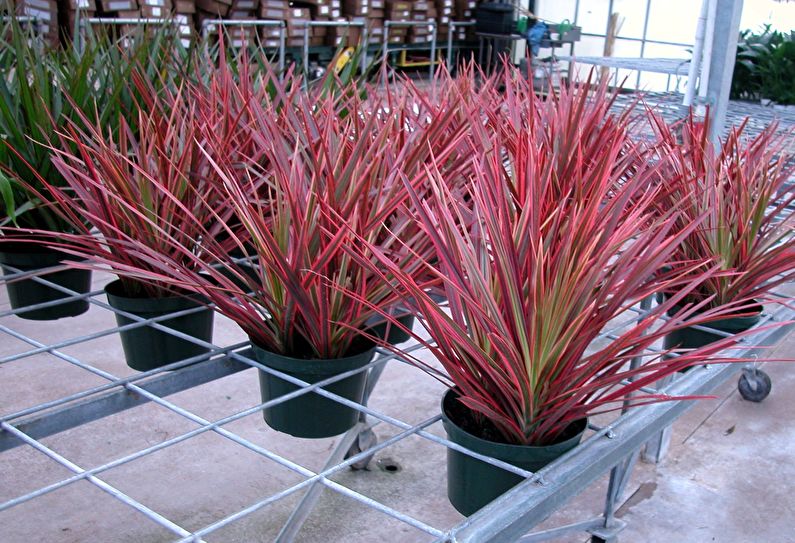
Humidity
The tropics and subtropics are known to be characterized by high humidity. Of course, in an apartment or office it will not be possible to create such a climate, but dracaena will always gratefully respond to spraying leaves with warm water from a spray bottle or installing a humidifier near it.
It is especially important to carry out such events in the winter, when heating works, and during the summer heat. In turn, the plant will work as a natural filter, purifying the air in the room from an excess of carbon dioxide or harmful fumes of formaldehydes, which are often found in furniture and modern decoration materials.
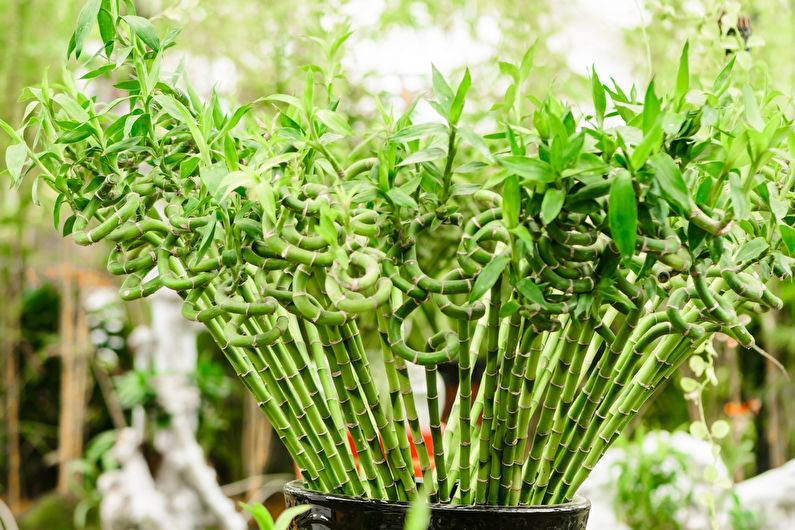
Watering
The only thing to remember when watering dracaena is moderation. The earth in the pot should always remain a little damp, but in no case should it turn into a swamp or rocky sand. The plant is well suited settled water at room temperature, in winter it can be slightly warmed up (up to 25-30 ° C).
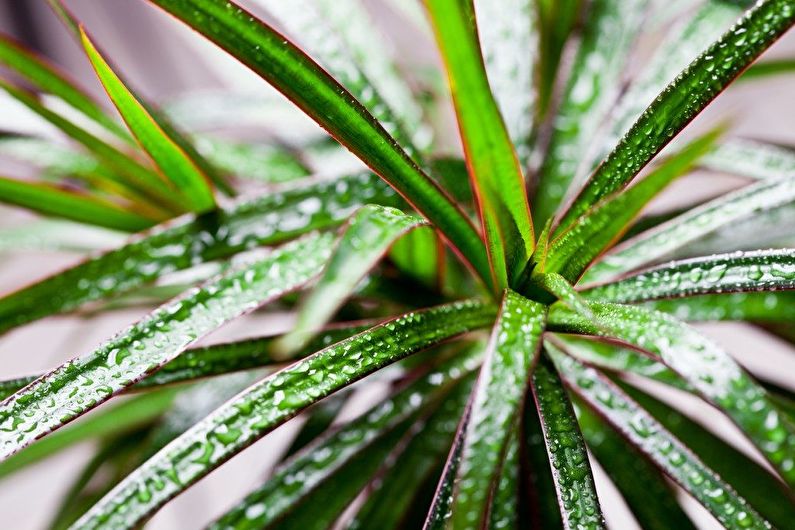

Fertilizers
As with any other plant, the growth of dracaena slows down in the autumn-winter period, so feeding should be carried out mainly from April to September. For this purpose, any mineral complexes for indoor plants that are sold in flower shops are suitable. They must be added in accordance with the instructions on the package (usually 1-2 times a month). With the same frequency, it is worth loosening the top layer of the soil to ensure air access to the roots.

Pest control
If even with good care, proper lighting and watering, the dracaena leaves still fall or lose their attractiveness, this may be due to pests. Timely measures against them will help to preserve the plant and prevent infection of other indoor flowers.
Spider mite. The eternal problem of gardeners is a lot of tiny spiders from light green to red-orange in color, which feed on leaves, leaving behind rusty spots and a sticky white web throughout the plant. This pest reproduces especially well at temperatures above + 30 ° C in dry, hot air. To save Dracaena from being destroyed by a spider mite, wiping the leaves with soap and water, regular warm showers and humidifying the climate as a whole will help. It is not recommended to use chemical preparations in this case - indoors they can cause allergies in people and indisposition of pets.
Scaffolds. They feed on plant cell juice, forming brown plaques on leaves and stems. After this, the dracaena often dries or turns yellow. Because insects are coated on top with a wax shield, insecticide spraying is rarely effective. At the initial stage of the lesion, the plaques can be wiped with a dense sponge, an old toothbrush, cotton wool soaked in soapy water or alcohol.After the physical removal of the parasites, they are treated with special chemicals that are absorbed into the leaves (Actellik, Actra, Fitoverm, etc.).
Thrips. These are tiny black insects about 1.5 mm in size. The characteristic traces of their life activity are elongated white and transparent silver spots, which become more and more on the leaves every day. To get rid of them, it is necessary to rinse the plant several times from all sides under a warm shower, and then spray the emulsion of malathion. In the summer, for this purpose, you can also use a decoction of yarrow or marigolds.
Aphid. Represents numerous colonies of sticky whitish larvae that feed on sap, due to which the leaves of dracaena wilt and gradually begin to fall off. Again, they must be washed off with a sponge with soapy water, and then treated with a special remedy for these insects (Neoron, Intavir, Fitoverm). Of folk methods, an infusion of celandine and a decoction of onion peel helps.
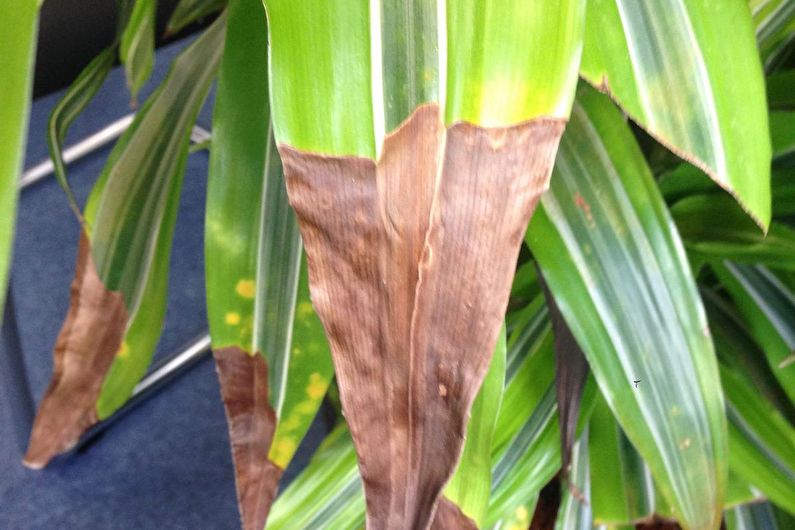
How to transplant dracaena
There may be several reasons for a dracaena transplant. A growing flower up to 3-4 years of life periodically requires a more capacious capacity so that the root system can develop normally. Adult plants, however, need replacing the soil as nutrients are washed out of it. Often transplanting into a new pot is also carried out for aesthetic reasons.
Preparing the soil for dracaena is a simple matter. To begin with, it is recommended that you fill up drainage — about pebbles, gravel, or expanded clay balls with a diameter of 1.5-2 cm — about 1/6 of the capacity. Excess water will easily drain through this layer, and the roots will have greater access to air.
As the main substrate, a standard peat-earth mixture from a flower shop is suitable. You can independently mix in equal proportions turf and sheet soil, sand and humus. It is not superfluous to add a little drainage elements (expanded clay, charcoal), add mineral additives (double superphosphate, potassium, dolomite flour, microfertilizers in the amount specified by the manufacturer).
To remove dracaena from the old tank, you can either let the earth dry without watering it for several days, or vice versa - thoroughly moisten it, so the roots will not break. It is advisable to choose a pot of such a diameter so that initially it has enough free space on all sides for future growth of the root system (at least 10 cm in depth).
So that after watering the earth does not dry out too quickly, it can be mulched on top with the same expanded clay, pieces of wood bark or slivers.
The ideal time for dracaena transplantation is the end of winter - the beginning of spring, when the plant resumes active growth and photosynthesis. After completing this procedure, the plant should be moistened as thoroughly as possible, avoiding drying out, and nourished with minerals.
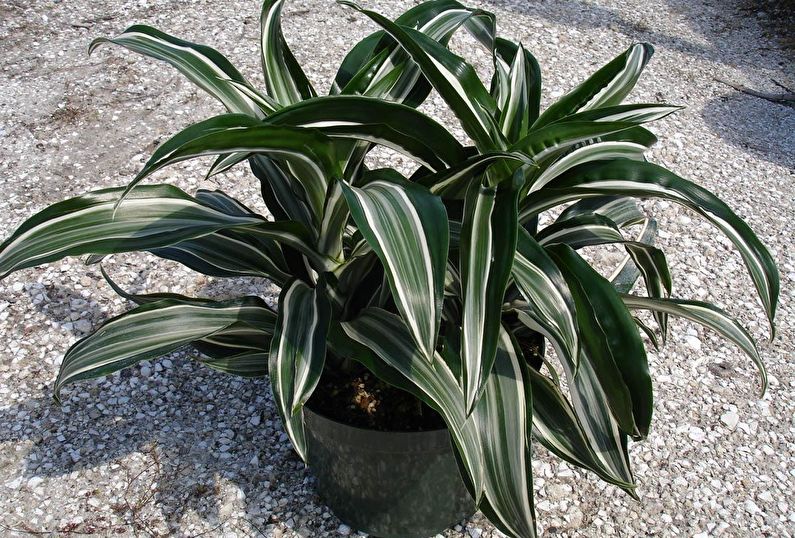
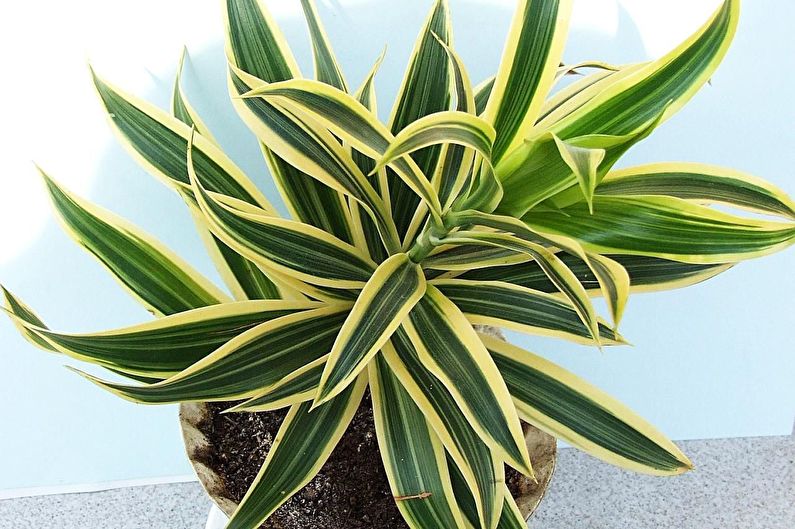
Dracaena propagation
Like most indoor flowers, dracaena propagated by cuttings. For this purpose, the apex or the stiffened parts of the stems are usually used, which under suitable conditions begin to take out new roots and young shoots.
When cutting the top with a sharp knife or secateurs, the upper part of the palm is cut off - the leaves along with the base, with a total height of at least 15-20 cm. You need to cut it with one confident movement so that the edges remain smooth and then sprouted. Parts of the stems can have a length of 10 to 20 cm.
Considering that when the top reproduces often leaves remain, it is usually immediately planted in the ground. This may be the substrate described above, or a lightweight neutral soil with a lot of sand and drainage elements in the mixture. The transplanted part of the plant needs to be sprayed 3-5 times a day and regular watering slightly above normal.
Cuttings of stalks can be carried out in a vertical or horizontal form - depending on how they are placed in the pot.With a vertical process, the process sinks into the ground at about half the height; with a horizontal one, it is only slightly pressed in the center, leaving both ends open.
To control the process, instead of soil, the shoots can be placed in clean water at room temperature. It should be changed at the first sign of turbidity, but dropping a tablet of activated carbon there, the liquid can be saved from bacteria and mold for a longer time.
It is recommended to carry out cuttings of dracaena in early spring - in March-April, when nature itself contributes to the renewal of plants. The hothouse conditions (+ 22-25 ° C, the greenhouse effect under a glass or film, frequent hydration), as well as the treatment of cut and water for irrigation with growth stimulants, help speed up the process. As a rule, noticeable roots and young shoots appear after 1.5-2 months.
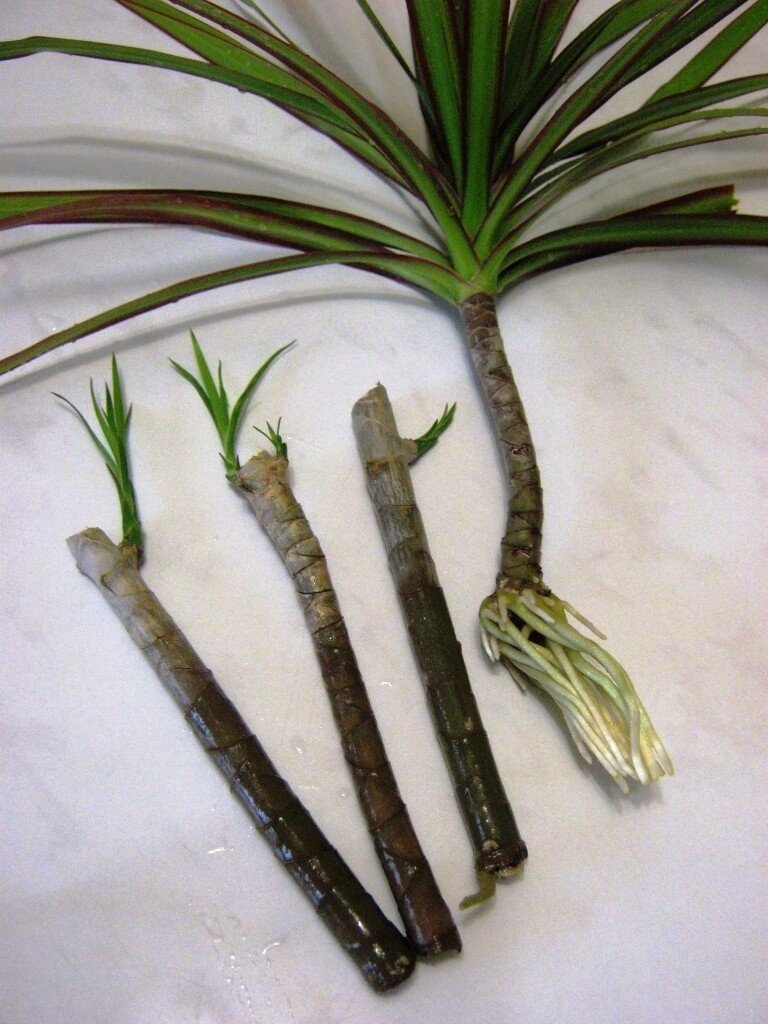
Video: Dracaena - Cropping, how to form a crown

